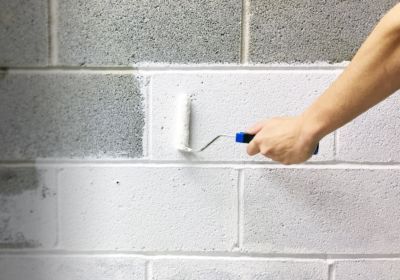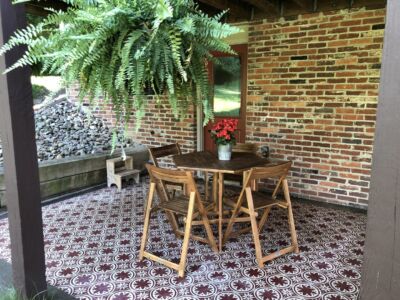
Bring a brand-new hue to basement or garage floors or turn your back patio into a retreat that’s the envy of all your neighbors with Real Milk Paint’s range of colors at your disposal.
If you think milk paint is only for furniture refinishing and other crafty DIY projects, think again. Although many professionals recommend epoxy coatings like elastomeric wall coating as a concrete paint or masonry paint, milk paint also offers a beautiful — and safe! — way to add color to concrete surfaces.
Benefits of Real Milk Paint as Concrete Paint
With products from the Real Milk Paint Co., there’s always an exciting home improvement transformation within reach. Because our milk paint is environmentally friendly and free from toxic off-gassing, it lets you decorate your home’s interior concrete and exterior concrete just how you want to with no volatile organic compounds (VOCs) or need for ventilation while you work. For example, a fresh coat of milk paint on concrete countertops beautifies the space without food contamination risks or costly kitchen remodeling.
Likewise, if your bathroom is in need of a facelift, you can save money on expensive tile by painting concrete floors with Real Milk Paint. The functionality extends outdoors as well, giving you options to change your patio floor paint or paint your bare concrete porch when you seal our paint with Pure Tung Oil.
From designing a playroom for the kids to turning an unfinished home extension into a cozy mother-in-law suite, our milk paint and home improvement products help you create welcoming, lively spaces your whole family loves.

Painting Existing Concrete
Add dimension, interest and beautiful color to plain concrete floors, countertops, walls and stairs with some help from Real Milk Paint. A coat of paint works wonders on utilitarian spaces in need of an update, and ours comes in a wide variety of colors to suit the needs of your paint concrete project.
It is important to note that in order to use Real Milk Paint on concrete, it will need to be unsealed or porous (think absorbent). If you happen to have sealed concrete, you may need to remove the seal with a stripper like Soy Gel.
The first step of this process is gathering supplies for your concrete paint project. These include:
- Real Milk Paint® powdered paint concrete
- Water for mixing your concrete paint
- A paint roller sized right for the task
- Wire brush, putty knife or scraper
- Spray bottle filled with water
- Any concrete paint additives you need
Mix Your Concrete Paints
To paint a concrete surface with Real Milk Paint, start by mixing the powdered medium with water at a 1:1 ratio. If you want your paint thicker for more opaque coverage, use a little less water. Likewise, if you want a more transparent look, add more water to create a wash. It takes about 10 to 15 minutes for the foam to dissipate after mixing Real Milk Paint®, so you can use that time to prepare the concrete for color.
One thing to watch out for when mixing your paint is excess foaming. Though some foaming is expected when mixing Real Milk Paint, foam that sticks around after a 10- to 15-minute wait has the potential to compromise your finish. Fortunately, a few drops of Real Milk Paint Anti-Foaming Agent should take care of any extra bubbles caused by overly vigorous mixing and help powdered pigments blend better for true, even color every time.
Clean the Concrete Surface
Next, clean your concrete surface with a power washer or a high-quality cleanser like our Tri-Sodium Phosphate, which leaves behind no residue for a perfectly dirt- and lint-free surface. If you discover any hardened stains, residue or old color on previously painted concrete surfaces, use a wire brush or paint scraper to remove the debris, then wipe down the masonry surfaces again with Tri Sodium Phosphate. If you have iron stains in your concrete from water, use Oxalic Acid to remove those pesky and unsightly blemishes. You can also use concrete primer for uneven parts and to help create a bond between the existing concrete and any new coating that is applied.
Double-Check Your Concrete Paint
 Before painting concrete floors and surfaces, double-check the consistency of your concrete paint — you may be able to gauge your mixture by sight, but you can also do a test patch to see whether your paint is thick enough to provide ample coverage without showing brush strokes or creating a viscous texture.
Before painting concrete floors and surfaces, double-check the consistency of your concrete paint — you may be able to gauge your mixture by sight, but you can also do a test patch to see whether your paint is thick enough to provide ample coverage without showing brush strokes or creating a viscous texture.
If your mixture is too thick, simply add a little water, stir it up and check again. If it’s too thin, add more paint powder, stir and do another test until you achieve the look you require. The optimum mixture should look like a heavy cream or fairly melted milk shake.
Paint Concrete With the Mixed Paint
In this step, prepare concrete paint by pouring it into containers easily accessible by your paint roller. Next, load up your roller and add the first coat of paint to the entire surface, working quickly yet smoothly.
Keep in mind that milk paint dries and absorbs very quickly on surfaces like basement floors or concrete basement walls, and sometimes the concrete paint even absorbs so quickly it gets sucked off the roller or paintbrush. To slow the absorption process, spray your concrete with water before painting, which allows the concrete paint to soak in more gradually and enables better blending.

Let the first coat of concrete paint dry few hours, then add a second coat to the painted surface. Let the second coat dry completely, then, if you have good coverage that delivers satisfying results, your paint job is complete, if not, a final coat may be necessary. Some spaces and objects, however, require one more step to ensure great results, and that’s adding a concrete sealer.
Finish the Surface With Concrete Sealer
Our versatile milk paint works as a concrete paint for both indoor and outdoor projects. When applying your milk paint to outdoor concrete surfaces that see heavy use or exposure to the elements, however, we recommend using a concrete sealer (such as our Pure Tung Oil) on the surface to help its durability, longevity and water resistance. Concrete sealer also prevents your concrete surface from soaking up concrete stain, dirt and grease to provide a cleaner, more pleasant space.
Using Milk Paint to Tint New Concrete
 If you’re pouring new concrete and want to add some color, simply stir your Real Milk Paint pigment powders right into the mix. The trick is getting the saturation just right. While we recommend five pounds of color per 94-pound bag of Portland Cement, light shades and pastels may require less paint powder, while deeper shades call for more. Never use more than 10 pounds of color per bag of cement, as that may affect the consistency and longevity of the final product.
If you’re pouring new concrete and want to add some color, simply stir your Real Milk Paint pigment powders right into the mix. The trick is getting the saturation just right. While we recommend five pounds of color per 94-pound bag of Portland Cement, light shades and pastels may require less paint powder, while deeper shades call for more. Never use more than 10 pounds of color per bag of cement, as that may affect the consistency and longevity of the final product.
Real Milk Paint improves your DIY concrete projects by adding color to such diverse spaces as a garage concrete floor, a basement wall, pool decks and front porches. Flexible, fresh and environmentally friendly, our concrete paints and finishing products help you achieve satisfying results with every use.



